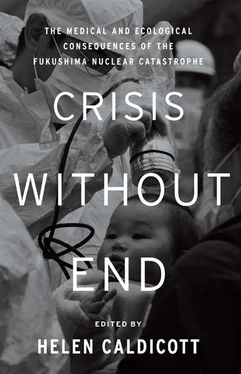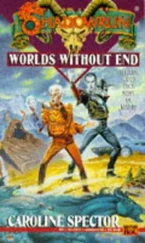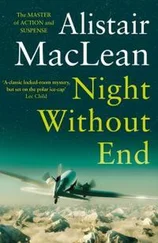In other words, the testing of U.S. foodstuffs is inadequate. The U.S. limit for cesium of 1,200 becquerels per kilogram is too high and is not binding, so the FDA can decide to act or not at any level of cesium contamination. It is little different from having no standard or limit at all. By comparison, Japan’s limit is 100 becquerels per kilogram, meaning that food too contaminated for Japan can be imported to the United States. No one has yet explained why children in the United States are allowed to ingest twelve times more radioactive poison than children in Japan. In any case, the release of contaminated food information to the public in the United States is at best paltry, if it is released at all.
After the initial release from Fukushima, radioactive iodine levels in Californian kelp were found to be significantly higher than before Fukushima. The researchers who conducted this study did not test the kelp for cesium, but they should, especially since kelp provides a food source for fish and there is concern that contamination will be concentrated in fish that feed on it.
California grass was found to contain 14 becquerels of cesium-134 and cesium-137 per kilogram. Grass, like kelp, is the beginning of a potential biomagnification chain, which could concentrate cesium in cattle. As the Berkeley monitoring site put it, “for understanding the time-dependence of food chain results, the grass and soil is what to look at.”
Pistachios that were grown in California and shipped to a Japanese supermarket were tested. They were found to contain 18 becquerels of cesium-134 and cesium-137 per kilogram. Beef raised in Japan was tested and approved for sale and then recalled, but not before it was fed to Japanese schoolchildren. This beef had contamination levels between 650 and 2,300 becquerels of cesium per kilogram. All of this beef could have been sold to the United States and the FDA may not have pulled it because, even though a contamination level of 2,300 becquerels of cesium per kilogram is above the FDA limit, this limit is not binding, meaning the FDA can choose to do nothing. Meanwhile, 162 kilograms of green tea were shipped to France from Japan and rejected because of the level of contamination, 1,038 becquerels of cesium per kilogram. The United States would have accepted this tea.
Bluefin tuna swam all the way across the Pacific and reached the California coast retaining cesium-134 and cesium-137. Canada’s cesium limit is 1,000 becquerels of cesium per kilogram and news reports expressed concern that Canada will also import highly contaminated fish from Japan—a concern that the United States should also share. Ocean life researchers were also concerned that contamination was higher in 2012 than it had been in 2011. This fits with cesium’s tendency to biomagnify. We need more testing and we need to think about how to test over a longer time frame, not just a few years. Testing in Japan recently found that wild blueberry jam imported from Italy, made from blueberries grown in Bulgaria, was contaminated above Japan’s 100-becquerels-per-kilogram cesium limit at approximately 140–160 becquerels per kilogram. Most likely its contamination is from the Chornobyl nuclear explosion, which points to the many sources of radioactive contamination, only one of which is Fukushima. Had a newspaper not tested the jam and publicly pressured the Japanese government to remove it from shelves, the preserves would still be available for sale. Meanwhile, this brand is sold in the United States as well and it carries the organic label. It is likely that U.S. parents who are trying to feed their children a higher-quality product, like organic preserves, are unwittingly and with no small measure of irony subjecting them to this radioactivity.
So how should we think about these contamination levels? What does the 1,200-becquerels-per-kilogram limit actually mean? Remember two things: there is no safe level of radiation, and cesium-134 and cesium-137 did not exist in nature before we created and released them.
The International Commission on Radiological Protection (ICRP) recommends how much radiation exposure can be tolerated by humans, and governments often follow these recommendations when setting standards. Nonetheless, when even very small amounts of cesium are ingested routinely, they can build up to unexpected levels in the body. After about three years, ingesting 10 becquerels of cesium-137 per day will cause a buildup of over 1,400 becquerels of cesium-137 in your body. For a child who weighs about 30 kilograms (66 pounds), this would be about 50 becquerels of cesium-137 per kilogram in the body. In studies of post-Chornobyl Belarus, cardiac abnormalities were seen in children whose bodies contained 10 to 30 becquerels of cesium per kilogram. Irreversible myocardial pathologies were observed at 50 becquerels per kilogram. Additional observed pathologies at these low levels included hormone imbalances, angina, diabetes, and hypertension.
In addition to these diseases, as cesium passes out of the body, its radioactivity damages the kidneys and bladder and the body’s ability to rid itself of the cesium. This could mean the total amount of cesium in a body could rise over time from chronic ingestion.
The high U.S. limits seem to be part of an official policy to encourage people to accept an increasingly radioactive food supply. Consider this from the ICRP report “Application of the Commission’s Recommendations to the Protection of People Living in Long-Term Contaminated Areas After a Nuclear Accident or a Radiation Emergency”: “There may be situations where a sustainable agriculture economy is not possible without placing contaminated food on the market. As such foods will be subject to market forces, this will necessitate an effective communication strategy to overcome the negative reactions from consumers outside the contaminated areas.” Their plan consists not of informing the public about what these contamination levels are so that we can decide for ourselves what is or is not appropriate. It consists instead of convincing us that man-made radiation in small doses is not harmful.
Beyond Nuclear, in coalition with other groups that are part of the Fukushima Fallout Awareness Network (FFAN), are petitioning the FDA for a binding contamination limit of 5 becquerels of cesium-134 and/or cesium-137 per kilogram instead of the current nonbinding 1,200 becquerels per kilogram. A 5-becquerels-per-kilogram limit is also close to that recommended by the International Physicians for the Prevention of Nuclear War (IPPNW) in their report “Calculated Fatalities from Radiation: Officially Permissible Limits for Radioactively Contaminated Food in the European Union and Japan.” Interestingly, each of the groups had arrived at this limit independent of the other, using two different methods of assessment. We are also asking that food testing be widespread and that the data be recorded in a publicly available database no matter what the cesium contamination level. If constructed properly, this could inform research on cesium mobility/biomagnification in the environment. It could be useful for consumers and researchers. The FDA petition process could drag on for a year or more and is, at the time of writing, still under way. In the meantime, there are a number of ongoing independent citizen monitoring attempts in the United States and Canada. At this point these are a patchwork of efforts born out of frustration at official inaction. We are attempting to coordinate a more integrated, scientifically rigorous structure, which would help ensure our food security by providing knowledge of which food is less contaminated or not contaminated at all.
In 2013, the American Medical Association called for testing seafood consumed in the United States for man-made radioactivity. Yet if the testing is based on the FDA cesium limit, we have circled back to the original problem: how is it all right to subject American children to twelve times more man-made radioactive poison than children in Japan? These limits are based on what is best for the nuclear industry. Clearly nothing else counts.
Читать дальше












![Helen Rowland - The Widow [To Say Nothing of the Man]](/books/752764/helen-rowland-the-widow-to-say-nothing-of-the-man-thumb.webp)